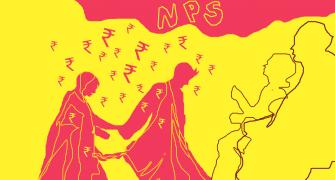From how to open an NPS Vatsalya account to knowing how this scheme compares to investing in mutual fund or in provident fund, Ramalingam Kalirajan offers a 360-degree view and the pros and cons of investing in a scheme that has the potential to secure your child's financial well-being.

Have you ever thought about when to start securing your child's financial future? The answer might be sooner than you think.
With the NPS Vatsalya Yojana, parents can open a National Pension System (NPS) account for their children right from birth until they turn 17. This unique initiative offers an early opportunity to start saving for your child's retirement, laying the foundation for their financial security early on.
After all, who wouldn't want to provide their child with the best possible start toward long-term financial stability?
From Vatsalya to Regular NPS: A Seamless Transition
Wondering what happens when your child turns 18?
The Vatsalya account effortlessly transitions into a regular NPS account, allowing them to continue saving with ease. And once they enter the workforce, their employers can contribute to their NPS account, further boosting their savings.
It's a structured and thoughtful way to ensure steady growth over time and to build a solid financial future for your child, isn't it?
Strong Returns Over Time: A Proven Track Record
NPS has consistently delivered strong returns over the years. For government sector participants, the compounded annual growth rate (CAGR) stands at an impressive 9.5 per cent.
Meanwhile, non-government accounts have seen robust growth too -- equities have returned 14 per cent, corporate debt has delivered 9.1 per cent, and government securities 8.8 per cent.
Launched in 2004 for government employees and extended to non-government employees in 2009, NPS has proven to be a reliable investment vehicle for long-term wealth creation.
NPS for Kids: A Future-Focused Approach
As parents, securing your child's future is a top priority, and the NPS Vatsalya account offers a unique and disciplined way to do that.
Setting up an account is straightforward -- just provide basic documents like your child's birth certificate, proof of identity, and KYC information. You can open the account at banks, pension fund houses, or even through the e-NPS portal.
Isn't that a convenient way to start planning your child's financial future?
Flexible Contributions with NPS Vatsalya
NPS Vatsalya offers the flexibility to contribute according to your financial capacity. While you're required to invest a minimum of Rs 1,000 per year, there's no upper limit, making it adaptable to various financial situations.
You also have the option to select from a range of pension fund managers registered with PFRDA. In terms of asset allocation, you have several options to consider.
1. Default Choice: Moderate Life Cycle Fund (LC-50)
For those who prefer a hands-off approach, the Moderate Life Cycle Fund (LC-50) automatically allocates 50 per cent of your investments into equities, offering a balanced strategy between risk and growth. It's a reliable choice for those looking for a stable, balanced approach, wouldn't you agree?
2. Auto Choice: Customisable for Your Risk Appetite
Prefer some control but still value automation? The Auto Choice feature offers flexibility. Parents can choose between three fund options based on their risk appetite:
- Aggressive LC-75: Allocates up to 75 per cent in equities for higher growth.
- Moderate LC-50: A balanced 50 per cent allocation to equities.
- Conservative LC-25: Limits equity exposure to 25 per cent for a safer approach.
Which option suits your investment style?
3. Active Choice: Full Control Over Fund Allocation
For hands-on investors, the Active Choice option allows you to directly manage your child's investments. You can allocate:
- Up to 75 per cent in equities for growth potential
- Up to 100 per cent in corporate debt
- Up to 100 per cent in government securities for safety and stability
Is NPS Vatsalya tax-free?
The contributions to the NPS Vatsalya account are locked until your child turns 60. Upon retirement, they can withdraw 60 per cent of the accumulated corpus tax-free, while the remaining 40 per cent is converted into an annuity to provide a steady income.
Although contributions to a regular NPS account are eligible for tax relief under Section 80C of the Income Tax Act, parents contributing to the Vatsalya account don't enjoy this benefit.
Partial Withdrawals: When and How?
- Life can be unpredictable, and NPS Vatsalya allows for partial withdrawals to address specific needs. Up to 25 per cent of the corpus can be withdrawn for purposes like education, and medical treatments for certain illnesses, or disabilities.
- Up to three partial withdrawals are allowed throughout the NPS tenure. Isn't it reassuring to know that you can access funds during critical moments?
Should You Subscribe to NPS Vatsalya?
NPS offers an appealing wealth accumulation opportunity with its equity component. You can allocate up to 75 per cent of your investments to equities, while the remainder can go into corporate bonds and government securities.
Based on your risk appetite, you can fine-tune your asset allocation for maximum growth.
Let's consider an example. Suppose you invest Rs 1,000 per month for your 10-year-old child, totaling Rs 12,000 annually. If your child continues with the same contribution after they turn 18, and assuming a 12 per cent compounded annual growth rate (CAGR), they would accumulate Rs 3.91 crore by the time they retire at 60. Isn't that a significant sum to secure their future?
NPS Vatsalya vs Mutual Funds: Which Is Better?
You might wonder, why choose NPS Vatsalya over mutual funds? Both options are excellent for wealth creation. Mutual funds offer flexibility, allowing you to withdraw funds whenever needed. Many child-specific mutual funds also have a shorter lock-in period of five years.
The key distinction lies in control.
NPS Vatsalya offers a more disciplined, structured approach to long-term growth, while mutual funds provide flexibility and liquidity. The better option for your child depends on whether you prioritise disciplined savings or flexible investment strategies.
Mutual Funds often deliver better returns than NPS due to their higher equity exposure and flexibility in fund selection. One of the standout features of MFs is the step-up option in SIPs, where you can periodically increase your contributions to align with rising income or changing financial goals.
In contrast, NPS has a more rigid structure with limited withdrawal options and mandatory annuitisation. For long-term wealth creation, MFs offer more growth potential and adaptability, wouldn't you agree?
What About the Good Old Public Provident Fund (PPF)?
The Public Provident Fund (PPF) has long been a trusted option for long-term savings. With a lock-in period of 15 years and a current interest rate of 7.1 per cent, it's an attractive choice for conservative investors seeking safe, steady returns.
But how does PPF compare to NPS Vatsalya?
With NPS Vatsalya, your child can tap into the power of equity markets and compounding, starting from a young age. This provides a distinct advantage for building long-term wealth. Isn't that an appealing way to plan for their future?
The Drawbacks of NPS Vatsalya: A Parent's Perspective
While NPS Vatsalya has its merits, some drawbacks must be considered. Shouldn't the immediate focus be on education rather than retirement planning?
i. Prioritising Education Over Retirement
Let's face it: your child's undergraduate and postgraduate education costs are more pressing than saving for their retirement. A strong educational foundation will set them up for a well-paying job, allowing them to start their own retirement planning once they begin working. Doesn't that seem like a more practical order of priorities?
Most parents today are already juggling their own retirement savings. Asking them to prioritise their child's retirement fund over educational expenses is tough, isn't it?
ii. Limited Flexibility with Partial Withdrawals
Although partial withdrawals are allowed for education, medical treatments, or disabilities, these are capped at 25 per cent of the corpus and can only be done three times. Given the rising costs of education, this limited withdrawal might not be enough to cover major expenses, especially as most educational costs come after your child turns 18.
iii. The Annuity Problem: Locked Until 60
Another limitation is that NPS Vatsalya locks the funds until your child turns 60. Even after that, a significant portion of the corpus is converted into an annuity. This restricts access to the full amount, which could be needed earlier in life for major expenses like buying a home or supporting a family.
Is NPS Vatsalya the Right Choice?
While the NPS Vatsalya Yojana is a well-intentioned scheme aimed at early retirement planning, it may not align with more immediate needs like education. For most parents, it might make more sense to encourage children to open their own NPS account once they start earning. Until then, focusing on educational savings could be a more practical approach.
- You can ask rediffGURU Ramalingam Kalirajan your questions HERE.
Ramalingam K, an MBA in Finance, is a Certified Financial Planner. He is the Director and Chief Financial Planner at holisticinvestment, a leading financial planning and wealth management company
Disclaimer: This article is meant for information purposes only. This article and information do not constitute a distribution, an endorsement, an investment advice, an offer to buy or sell or the solicitation of an offer to buy or sell any securities/schemes or any other financial products/investment products mentioned in this article to influence the opinion or behaviour of the investors/recipients.
Any use of the information/any investment and investment related decisions of the investors/recipients are at their sole discretion and risk. Any advice herein is made on a general basis and does not take into account the specific investment objectives of the specific person or group of persons. Opinions expressed herein are subject to change without notice.










